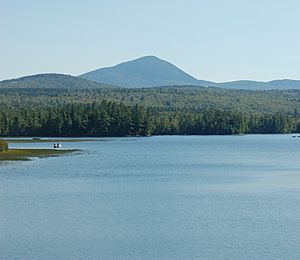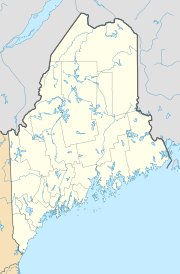Weld, Maine facts for kids
Quick facts for kids
Weld, Maine
|
|
|---|---|

Webb Lake and Mount Blue
|
|
| Country | United States |
| State | Maine |
| County | Franklin |
| Incorporated | 1816 |
| Communities |
|
| Area | |
| • Total | 62.87 sq mi (162.83 km2) |
| • Land | 59.50 sq mi (154.10 km2) |
| • Water | 3.37 sq mi (8.73 km2) |
| Elevation | 676 ft (206 m) |
| Population
(2020)
|
|
| • Total | 376 |
| • Density | 6/sq mi (2.4/km2) |
| Time zone | UTC-5 (Eastern (EST)) |
| • Summer (DST) | UTC-4 (EDT) |
| ZIP code |
04285
|
| Area code(s) | 207 |
| FIPS code | 23-81300 |
| GNIS feature ID | 0582798 |
Weld is a small town in Franklin County, Maine, United States. In 2020, about 376 people lived there. Weld is known for its beautiful scenery. It sits next to Webb Lake and is almost surrounded by mountains. The town is home to Mount Blue State Park, a great place for outdoor activities. It also has two summer camps: Camp Kawanhee for Boys and Camp Lawroweld.
Contents
History of Weld, Maine
Weld was first called No. 5 or Webb's Pond Plantation. Nathaniel Kittredge and his family from Chester, New Hampshire were the first settlers in 1800. The land was part of a large area bought by Jonathan Phillips of Boston around 1790. Phillips was an investor who sold parts of the land to new settlers.
How Weld Got Its Name
In 1815, Benjamin Weld of Boston, along with Jacob Abbott and Thomas Russell Jr., bought the remaining land from Phillips. The town was officially created on February 8, 1816. It was named after Benjamin Weld, one of the owners. The year 1816 was unusual because it was known as the Year Without a Summer. The weather was very cold, which made it hard for communities in the northeastern United States to grow food.
Pomp Russell's Story
A special person who lived in Weld for a long time was Pomp Russell. He was an African-American man adopted by Thomas and Bethia Holt Russell in Massachusetts in the 1760s. Pomp fought in the Battle of Bunker Hill in June 1775 during the American Revolutionary War. He was even caught spying behind British lines but managed to escape before he could be shot.
Around 1781, when Pomp was 21, his adoptive father, Thomas, gave him his freedom. Pomp married Margaret Cutt in 1788. They had their first child, Peter, in 1789. Later, his brothers, Abel and Joseph, invited Pomp and his family to move to Weld, Maine. They even built a home for Pomp's family on Center Hill in Weld.
Early Life and Industries
Weld is located on a flat area with good soil, surrounded by mountains. Early farmers grew crops like corn, potatoes, wheat, and oats. Weld was also famous for its many apple orchards.
The town's streams provided water power for different mills. There were five sawmills (for cutting wood), three box mills, a gristmill (for grinding grain), and a carding machine (for preparing wool). Weld also made things like fork and shovel handles, butter tubs, harnesses, and tinware. Other businesses included a starch factory, a blacksmith shop, and a tannery (for making leather). By 1870, the town's population had grown to 1,130 people.
Geography of Weld
Weld covers about 62.87 square miles (162.83 square kilometers). Most of this area is land, with about 3.37 square miles (8.73 square kilometers) being water. The town is located next to Webb Lake. The Webb River flows out of Webb Lake and eventually joins the Androscoggin River.
Nearby Towns and Roads
State routes 142 and 156 pass through Weld. The town shares its borders with:
- Phillips and Unincorporated Township No. 6 to the north.
- Avon and Temple to the east.
- Carthage and Perkins Plantation to the south.
Weld is home to Spruce Mountain and Hurricane Mountain. It is also considered close to other famous mountains like Tumbledown Mountain and Mount Blue, even if they are just outside the town's exact boundaries.
Weld's Population Over Time
| Historical population | |||
|---|---|---|---|
| Census | Pop. | %± | |
| 1820 | 489 | — | |
| 1830 | 765 | 56.4% | |
| 1840 | 1,045 | 36.6% | |
| 1850 | 995 | −4.8% | |
| 1860 | 1,035 | 4.0% | |
| 1870 | 1,130 | 9.2% | |
| 1880 | 1,040 | −8.0% | |
| 1890 | 885 | −14.9% | |
| 1900 | 738 | −16.6% | |
| 1910 | 574 | −22.2% | |
| 1920 | 521 | −9.2% | |
| 1930 | 493 | −5.4% | |
| 1940 | 422 | −14.4% | |
| 1950 | 361 | −14.5% | |
| 1960 | 348 | −3.6% | |
| 1970 | 360 | 3.4% | |
| 1980 | 435 | 20.8% | |
| 1990 | 430 | −1.1% | |
| 2000 | 402 | −6.5% | |
| 2010 | 419 | 4.2% | |
| 2020 | 376 | −10.3% | |
| U.S. Decennial Census | |||
Population in 2010
In 2010, the census showed that 419 people lived in Weld. There were 194 households, which are groups of people living together. About 138 of these were families. The population density was about 7 people per square mile. This means the town is not very crowded.
Most of the people in Weld (97.9%) were White. A small number were African American or from other backgrounds. About 0.2% of the population identified as Hispanic or Latino.
About 15.5% of households had children under 18 living with them. Most households (64.4%) were married couples. The average age in Weld was 54 years old. About 11% of residents were under 18, and nearly 24% were 65 or older.
Notable People from Weld
- Henry Braun, a poet
- C. J. Stevens, an author
- John B. Taft, who was a state legislator in Minnesota
See also
 In Spanish: Weld (Maine) para niños
In Spanish: Weld (Maine) para niños






